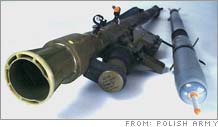 |
| An arms dealer was arrested 2 years ago for trying to sell shoulder-fired anti-aircraft missile to undercover agents. |
|
|
|
WASHINGTON (CNN) - It would cost $11 billion to install anti-missile systems on the nation's 6,800 commercial airliners, and billions more to maintain the unproven systems, a study said Tuesday.
According to the RAND study, the government should postpone a decision on installing the devices until they are more economical and reliable.
The study said operating costs alone for the missile countermeasures would consume $2.1 billion a year -- almost half of the money spent annually on all transportation security.
"When you look at those figures, we think it is too expensive," said report co-author James Chow. But, he added, the investment could be justified if the costs decrease, or if the budget for transportation security grows significantly.
The RAND report comes as government and airline officials tussle with the best way to protect airliners from what could be their biggest threat -- shoulder-fired missiles, or MANPADS.
While no U.S. airliner has been brought down by MANPADS (man-portable air defense systems), the weapons are cheap, plentiful and have been used successfully overseas. In November, a DHL cargo plane was damaged shortly after take-off from Baghdad International Airport.
The RAND report says the shoulder-fired missiles are likely to become more attractive to terrorists, especially as the government tightens other airplane and airport security measures.
The report attempts to weigh the cost of protecting airliners against the cost of a successful attack.
RAND calculates that it would cost about $40 billion over 20 years to develop, procure and operate anti-missile systems.
The cost of a successful missile attack would also be significant. The United States would incur "direct" costs of approximately $1 billion for every aircraft downed, the report says.
Indirect economic damage would be far greater. If air travel was shut down for a week, the loss would amount to roughly $3 billion during the shutdown, with a long-range impact that could increase the loss to $15 billion.
But the report suggests it would be wasteful to rush into a counter-MANPADS program, saying terrorists could devise tactics to defeat whatever countermeasures have been installed.
Given the costs and uncertainties, "we believe a decision to install such systems aboard commercial airliners should be postponed until the technologies can be developed," the report says. "This development effort should proceed as rapidly as possible."
It says the current Department of Homeland Security strategy of research and development is a prudent step.
Choices
The government is currently looking at three main types of missile thwarting systems: flares, laser jammers and high-energy lasers (HELs). The first two aim to confuse the seeker of an infrared missile while the HEL aims to destroy the missile regardless of how it is guided.
Some military aircraft already have anti-missile systems. And Israel's El Al airline announced late last year it would begin installing an Israeli-made system on its aircraft, beginning with a Boeing jet. In November of 2002, terrorists unsuccessfully attacked an Israeli airliner in Kenya.
In the United States, officials are attacking the issue from numerous angles. Some U.S. airports have stepped up patrols around airport perimeters to fend off possible attacks on jets, which are most vulnerable on take-off.
DHS Undersecretary Asa Hutchinson said the department also has trained thousands of border inspectors to detect MANPADS components being smuggled into the country.
Chow said the government also should study which aircraft are most susceptible to missile attack, so that anti-MANPADS systems can be placed on the most vulnerable aircraft, and find ways to improve airliners' ability to survive MANPADS strikes.
And the government should work to stem the proliferation of MANPADS, and buy back weapons on the world's arms markets, particularly newer, more sophisticated MANPADS that can thwart counter-measures.
RAND says a multilayered approach is important "because no single countermeasure technology can defeat all possible MANPADS attacks with high confidence."

|